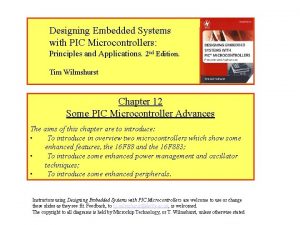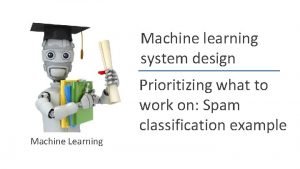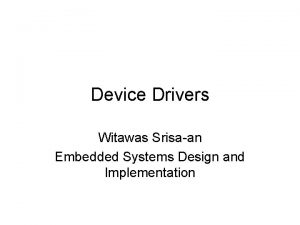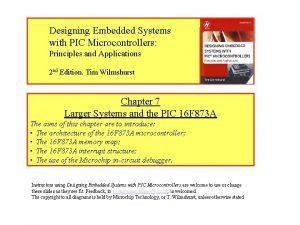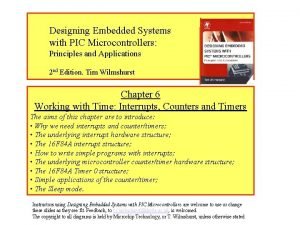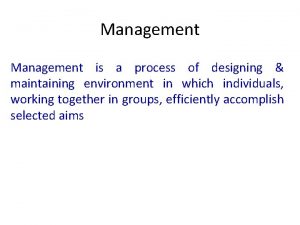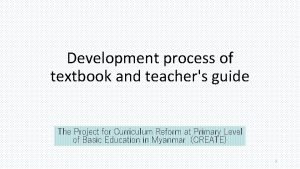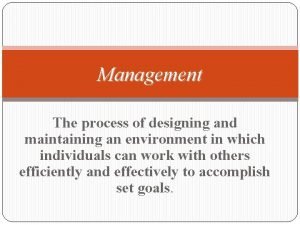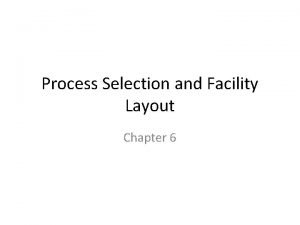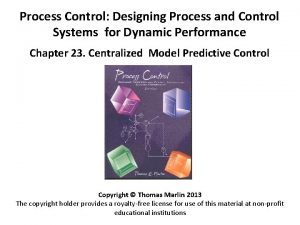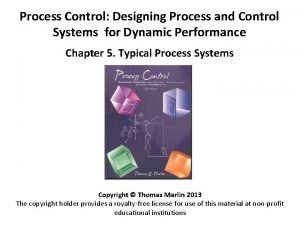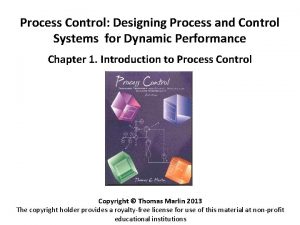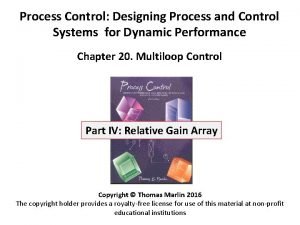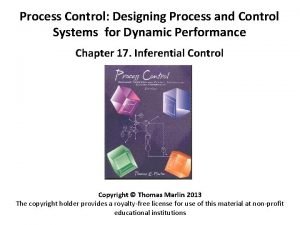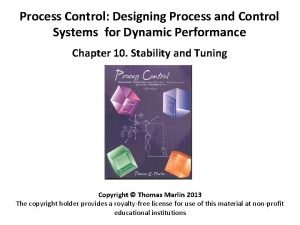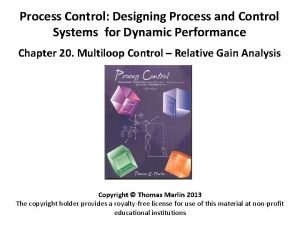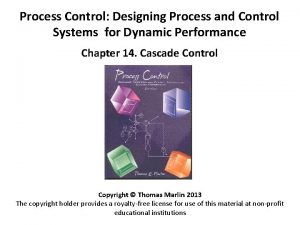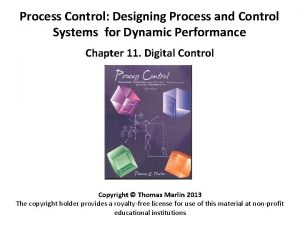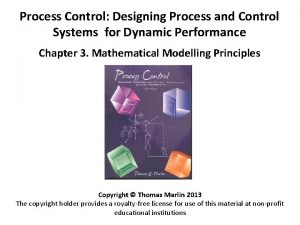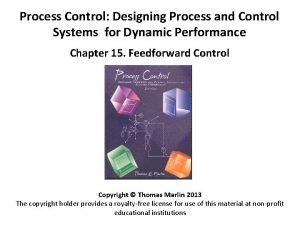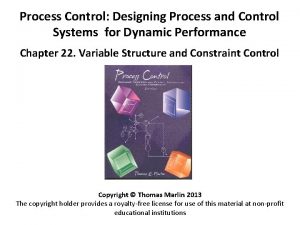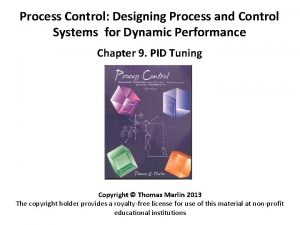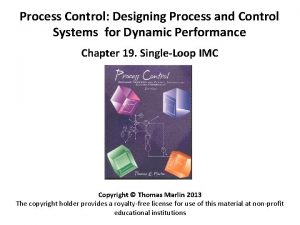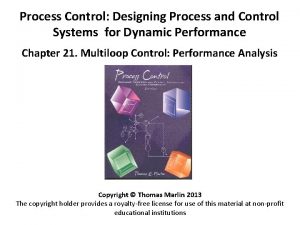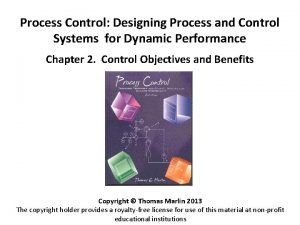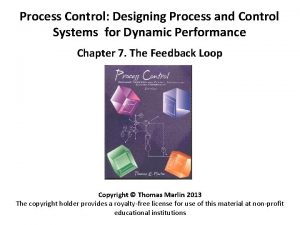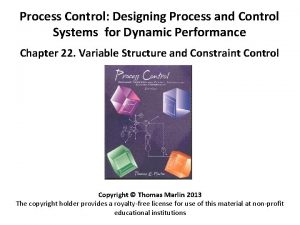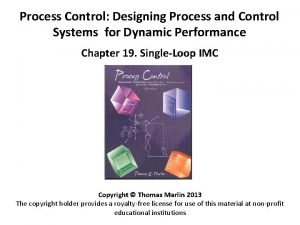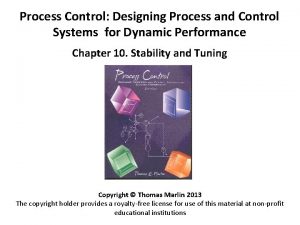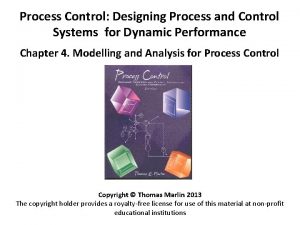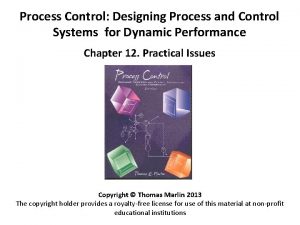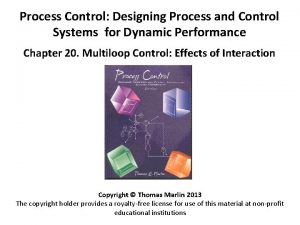Process Control Designing Process and Control Systems for






































- Slides: 38

Process Control: Designing Process and Control Systems for Dynamic Performance Chapter 18. Level Control Copyright © Thomas Marlin 2013 The copyright holder provides a royalty-free license for use of this material at non-profit educational institutions

CHAPTER 18: LEVEL CONTROL When I complete this chapter, I want to be able to do the following. • Determine the proper location and volume of liquid inventories in a process • Determine the dynamics of typical level processes • Tune level controllers for two typical control objectives

CHAPTER 18: LEVEL CONTROL Outline of the lesson. • Levels, where are they? • Levels - good and bad aspects • Level dynamics • Level tuning • Determining inventory size

CHAPTER 18: LEVEL CONTROL • Where are liquid inventories? • Why do we design equipment with inventories?

CHAPTER 18: LEVEL CONTROL • Where are liquid inventories? PC-1 L 4 P 3 T 5 LC-1 17 F 7 16 LC-2 d. P-1 15 T 6 AC-1 T 10 3 TC-7 F 3 d. P-2 2 F 4 1 LC-3 F 9 F 8

CHAPTER 18: LEVEL CONTROL • Where are liquid inventories? Why? • Liquid mixing reduces effects of composition disturbances Liquid on trays, allows liquid-vapor equilibrium Allows uninterrupted reflux and product flows in spite of variable condensation • Flow to tower can be constant in spite of fluctuation in feed flow Uninterrupted fluid flow to pump Liquid covers the heat exchanger transfer area

CHAPTER 18: LEVEL CONTROL • How do inventories affect performance of the process containing the liquid? Strongly • Volume of chemical reactors, volume has strong effect on conversion • Fast material degradation (reduce residence time) Weakly • Equilibrium stages, both phases must be present, but amount beyond minimum does not affect process • Heat exchangers, must have contact with area Insignificant • Drums and tanks, no change to material properties But these inventories have strong effects on the other processes influenced by the flows from these inventories

CHAPTER 18: LEVEL CONTROL • What are ++ and -- for having liquid inventories? POSITIVE ASPECTS Conclusion: ? ? NEGATIVE ASPECTS

CHAPTER 18: LEVEL CONTROL • What are ++ and -- for having liquid inventories? POSITIVE ASPECTS NEGATIVE ASPECTS • Provide liquid to pumps • Hazards - large inventory • Mixing to reduce effects of stream property disturbances • Product quality - degradation • Inventory enables flow out constant as flow in varies • Required - process principles, e. g. , - chemical reactors - heat exchangers • Space in plant • Cost - Equipment costs - Material costs (inventory) Conclusion: We use only the minimum liquid inventory needed to achieve the desired process performance.

CHAPTER 18: LEVEL CONTROL To design control, we need to understand the • • process dynamics control objectives algorithm & tuning level sizing Let’s determine the dynamics for each of the designs

CHAPTER 18: LEVEL CONTROL Quick reminder of key property of dynamic process behavior Self-regulatory Non-self-regulatory 0 -0. 5 New steady state -1 Level 0 -1. 5 -2 No new steady state -1 -1. 5 0 5 10 15 20 25 30 35 40 -2 45 0 5 10 15 20 Time 1. 5 Flow out 2 1 0. 5 0 25 30 35 40 45 Time 1 0. 5 0 5 10 15 20 25 30 35 40 Time Fout increases as level increases 45 0 0 5 10 15 20 Time Fout does not depend on the level

Determine if each 18: level is self-regulatory or not CHAPTER LEVEL CONTROL Constant Self-regulatory Level 0 -0. 5 -1 10 15 20 25 Time 30 35 40 -20 45 2 Flow out -20 -1 -1. 5 10 15 20 25 Time 30 35 40 45 1. 5 1 1 0. 5 00 5 5 10 15 20 25 Time 30 35 40 00 45 P 1 = pump head + g. L 0 Non-Self-regulatory P 1 = P 3 + g. L 0

CHAPTER 18: LEVEL CONTROL Fin LC To design control, we need to understand the • • process dynamics control objectives algorithm & tuning level sizing Let’s determine the control objectives for level control What is important? • The level • The manipulated flow Fout

CHAPTER 18: LEVEL CONTROL Control objectives Fin 1. Since the level in unstable, we must control it! LC 2. We have two different categories of objectives A. Tight level control for levels that strongly influence process performance (or are very small). - Level near set point, aggressive flow adjustments B. Averaging level control for drums and tanks, where smooth manipulation of flows will be beneficial to other units in the plant. - Level far from set point (but doesn’t overflow), slower flow adjustments Fout

CHAPTER 18: LEVEL CONTROL Fin LC To design control, we need to understand the • • process dynamics control objectives algorithm & tuning level sizing Let’s determine the control objectives algorithm & tuning for level control Fout 1. Is the control in the figure a. b. c. d. feedback feedforward neither both 2. What makes control difficult?

CHAPTER 18: LEVEL CONTROL Fin Since this is feedback, let’s use the old standard, PI control (“D” isn’t needed). LC Fout 1. Is the control in the figure a. b. c. d. feedback feedforward neither both 2. What makes control difficult? Feedback: The flow out has a causal effect on the level. Dead time makes feedback difficult, but we see that this process has negligible dead time!

CHAPTER 18: LEVEL CONTROL Controlled Variable S-LOOP plots deviation variables (IAE = 608. 1005) Controller Tuning 0. 8 Determine a model using the process reaction curve experiment. 0. 6 0. 4 0. 2 Manipulated Variable Can we use the standard PI tuning approach shown in the schematic? DYNAMIC SIMULATION 1 0 0 5 10 15 20 25 Time 30 35 40 45 50 1 0. 8 0. 6 0. 4 0. 2 0 0 25 30 Time 40 45 50 Determine the initial tuning constants from a correlation. TI Kc D = Fin 35 CV = L MV = Fout S-LOOP plots deviation variables (IAE = 9. 7189) Controlled Variable 1. 5 1 0. 5 0 0 20 40 60 Time 80 100 120 1. 5 Manipulated Variable LC 1 0. 5 0 Apply and fine tune as needed.

Controlled Variable S-LOOP plots deviation variables (IAE = 608. 1005) DYNAMIC SIMULATION 1 0. 8 0. 6 0. 4 0. 2 5 00 10 15 20 25 30 35 40 45 Time 15 25 30 35 40 45 50 10 20 Time Flow out Manipulated Variable The level process is unstable. Without control, it never reaches a new steady state Level CHAPTER 18: LEVEL CONTROL 1 0. 8 0. 6 0. 4 Cannot determine a model using the process reaction curve experiment. 0. 2 0 0 0 5 5 10 15 20 25 30 Time 35 40 45 50 10 15 20 25 30 35 40 45 Time D = Fin CV = L LC MV = Fout Standard tuning charts are not applicable to a nonself-regulating level. Kc TI Cannot determine the initial tuning constants from Ciancone (or Ziegler. Nichols step) correlation.

CHAPTER 18: LEVEL CONTROL D(s) D = Fin SP(s) CV = L E(s) + A = cross sectional area LC MV = Fout Gd(s) CV(s) MV(s) GC(s) Gv(s) GP(s) - + + CVm(s) GS(s) Let’s build a model of the process with the controller, i. e, the closedloop system. We will ignore the fast sensor and valve dynamics. Using block diagram algebra, we obtain With Gc(s) being either P-only of PI For a non-self regulating level

CHAPTER 18: LEVEL CONTROL D = Fin CV = L A = cross sectional area LC MV = Fout We substitute the appropriate models for each process and controller to obtain the following transfer function models, which we can solve analytically for a step disturbance! Proportional-only control Proportional-integral control

CHAPTER 18: LEVEL CONTROL P-only PI • Disturbance step response • Stable, first order • Stable, second order • Never underdamped • Underdamped when < 1 (We want overdamped!) • Non-zero s-s offset • Zero s-s offset

CHAPTER 18: LEVEL CONTROL P-only Tuning Determine the expected maximum step disturbance size ( Fmax) and calculate the Kc to give the maximum allowed change in the level ( Lmax). Note, level does not return to its set point. Fmax LC When is this O. K? Fout = ? ? Kc = - ( Fmax)/ ( Lmax)

CHAPTER 18: LEVEL CONTROL PI Tuning • Determine the expected maximum step disturbance size ( Fmax) and calculate the Kc and TI to give the maximum allowed change in the level ( Lmax). • Set tuning so that damping coefficient, = 1. Note, level returns to its set point. Fmax LC Fout = ? ? Fout Kc = - 0. 736 ( Fmax)/ ( Lmax) TI = 4 ( 2) A/(-Kc)

CHAPTER 18: LEVEL CONTROL Let’s use these results for averaging and tight level control. Fin LC P-only control: Fout Kc = - ( Fmax)/ ( Lmax) PI Control: Kc = - 0. 736 ( Fmax)/ ( Lmax) TI = 4 ( 2) A/(-Kc) Averaging level control, Lmax 40% of maximum range Tight level control, Lmax 5% of maximum range

CHAPTER 18: LEVEL CONTROL How do we determine the proper vessel volume? Fin To design control, we need to understand the • process dynamics • control objectives • algorithm & tuning • level sizing Let’s determine the Let’s lookobjectives again at the control process for level control V=? LC That is a good question. Averaging level control will not provide improvement unless the vessel is large enough! Fout

CHAPTER 18: LEVEL CONTROL One key design goal: maintain the rate of change of the manipulated flow below a maximum when using averaging tuning. This “protects” the downstream units from fast disturbances. Fmax Lmax V=? LC Fout The equation is based on a PI controller with the “averaging” tuning recommended in this chapter. See Chapter 18 for derivation

CHAPTER 18: LEVEL CONTROL Now, we understand control of a single level! Fin LC To design control, we need to understand the • • process dynamics control objectives algorithm & tuning level sizing How small can we make the levels? Do we have a guideline? Fout

CHAPTER 18: LEVEL CONTROL Process plants have many units in series. Inventory control behaves similar to a series of tanks. How should they be controlled? “Feed push” with levels adjusting flows out F 0 F 1 F 2 LC LC LC F 3 “Product pull” with levels adjusting flows in F 0 F 1 LC F 2 LC LC F 3

CHAPTER 18: LEVEL CONTROL For a series of levels, what is the importance of damping? We see that flow variation increases with number of levels in series Best P-only • P-only control is not oscillatory • PI ( =1) experiences overshoot • PI ( =0. 5) experiences large oscillations PI ( =1) F 0 Step change F 1 LC F 2 LC LC F 3 Not acceptable PI ( =0. 5)

CHAPTER 18: LEVEL CONTROL WORKSHOP 1 We can have a liquid inventory that is not controlled, if the vessel is large enough. Let’s look at an example. Fin What is the minimum volume for the storage tank? Flow rate Plot the level vs. time. L Time (days) 1/2 5 The flow in involves batches of 24, 000 m 3 delivered over 12 hours, with a batch delivered every five days. Fout The flow out is the feed to the plant. It must be continuous and have a constant value.

CHAPTER 18: LEVEL CONTROL WORKSHOP 2 The principles we have learned for liquid level control apply to solid and gas inventories as well. 1. Think of an example in a process plant in which we need to have an inventory of a. (granular) solids b. gas 2. Describe the storage equipment for each. 3. Select a sensor to measure the inventory for each 4. Determine whether the inventory is self-regulating or non-selfregulating. 5. Sketch the process with control.

CHAPTER 18: LEVEL CONTROL WORKSHOP 3 Discuss how you determine the proper liquid inventories for the following unit operations. 1. Liquid on the shell side of a shell and tube heat exchanger. 2. Liquid on a distillation tray

CHAPTER 18: LEVEL CONTROL WORKSHOP 3 Discuss how you determine the proper liquid inventories for the following unit operations. 3. Liquid in a flash drum 4. Liquid in a CSTR F T A L

CHAPTER 18: LEVEL CONTROL WORKSHOP 4 Calculate the level tuning for the situation described below. Determine the tuning for tight and for averaging control. Fin V = 50 m 3 A = 25 m 2 F = 1. 5 m 3/min LC Fout Fmax = 1. 0 m 3/min For each tuning, what would be the maximum rate of change of the manipulated flow for a step disturbance of Fmax = 1. 0 m 3/min?

CHAPTER 18: LEVEL CONTROL When I complete this chapter, I want to be able to do the following. • Determine the location and volume of liquid inventories in a process • Determine the dynamics of various level processes • Tune level controllers for both typical control objectives Lot’s of improvement, but we need some more study! • Read the textbook • Review the notes, especially learning goals and workshop • Try out the self-study suggestions • Naturally, we’ll have an assignment!

CHAPTER 18: LEARNING RESOURCES • SITE PC-EDUCATION WEB - Instrumentation Notes - Level sensors! - Interactive Learning Module (Chapter 18) - Tutorials (Chapter 18) • The Textbook, naturally, for many more examples. • An entire book on inventory control? Sure, it is an important issue in corporate-wide production management. Nahmias, S. , Production and Operations Analysis, Mc. Graw-Hill Irwin, New York, 2001.

CHAPTER 18: SUGGESTIONS FOR SELF-STUDY 1. Storing hazardous materials increases the risk in case of an accident. Search the WEB for information on the incident at Bhopal, India. Discuss the effect of the storage volume of methyl isocyanate on the number of deaths. A good place to start is http: //www. unu. edu/unupress/unupbooks/uu 21 le 00. htm#Contents 2. You are designing a reflux drum for a distillation tower that operates at 10 atm. How does the cost of a carbon steel, horizontal drum depend on the volume? 3. Discuss how you would monitor the performance of averaging level control. Based on plant data, define rules for fine tuning the controller.

CHAPTER 18: SUGGESTIONS FOR SELF-STUDY 4. Inventories are provided for all essential materials. Discuss how you would determine the proper storage inventory for some key materials, such as a. Blood for transfusions b. Food, e. g. , grains and rice c. Water for a city 5. Describe the physical principles for sensors to measure the inventory of liquids, gases, and solids.
 Designing embedded systems with pic microcontrollers
Designing embedded systems with pic microcontrollers Machine learning system design examples
Machine learning system design examples Designing device drivers for embedded systems
Designing device drivers for embedded systems Data memory
Data memory Designing embedded systems with pic microcontrollers
Designing embedded systems with pic microcontrollers The process of designing and maintaining an environment
The process of designing and maintaining an environment Process of textbook development
Process of textbook development The process of designing and maintaining an environment
The process of designing and maintaining an environment Product vs process layout
Product vs process layout Layouts that can handle varied processing requirements
Layouts that can handle varied processing requirements Process control systems
Process control systems Product inspection vs process control
Product inspection vs process control Formuö
Formuö Typiska drag för en novell
Typiska drag för en novell Tack för att ni lyssnade bild
Tack för att ni lyssnade bild Vad står k.r.å.k.a.n för
Vad står k.r.å.k.a.n för Shingelfrisyren
Shingelfrisyren En lathund för arbete med kontinuitetshantering
En lathund för arbete med kontinuitetshantering Särskild löneskatt för pensionskostnader
Särskild löneskatt för pensionskostnader Tidbok
Tidbok Sura för anatom
Sura för anatom Densitet vatten
Densitet vatten Datorkunskap för nybörjare
Datorkunskap för nybörjare Boverket ka
Boverket ka Att skriva debattartikel
Att skriva debattartikel För och nackdelar med firo
För och nackdelar med firo Nyckelkompetenser för livslångt lärande
Nyckelkompetenser för livslångt lärande Påbyggnader för flakfordon
Påbyggnader för flakfordon Kraft per area
Kraft per area Offentlig förvaltning
Offentlig förvaltning Jag har gått inunder stjärnor text
Jag har gått inunder stjärnor text Presentera för publik crossboss
Presentera för publik crossboss Argument för teckenspråk som minoritetsspråk
Argument för teckenspråk som minoritetsspråk Plats för toran ark
Plats för toran ark Klassificeringsstruktur för kommunala verksamheter
Klassificeringsstruktur för kommunala verksamheter Mjälthilus
Mjälthilus Claes martinsson
Claes martinsson Cks
Cks Byggprocessen steg för steg
Byggprocessen steg för steg
